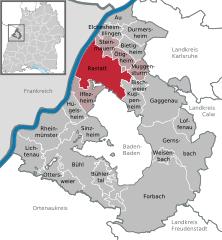Rastatt
| Rastatt | ||
|---|---|---|
_2.jpg) | ||
| ||
 Rastatt | ||
Location of Rastatt within Rastatt district 
 | ||
| Coordinates: 48°51′N 8°12′E / 48.850°N 8.200°ECoordinates: 48°51′N 8°12′E / 48.850°N 8.200°E | ||
| Country | Germany | |
| State | Baden-Württemberg | |
| Admin. region | Karlsruhe | |
| District | Rastatt | |
| Government | ||
| • Mayor | Hans Jürgen Pütsch | |
| Area | ||
| • Total | 59.02 km2 (22.79 sq mi) | |
| Elevation | 115 m (377 ft) | |
| Population (2015-12-31)[1] | ||
| • Total | 48,051 | |
| • Density | 810/km2 (2,100/sq mi) | |
| Time zone | CET/CEST (UTC+1/+2) | |
| Postal codes | 76401-76437 | |
| Dialling codes | 07222, 07229 | |
| Vehicle registration | RA | |
| Website | rastatt.de | |
Rastatt (German: [ˈʁaʃtat]) is a town and baroque residence in the District of Rastatt, Baden-Württemberg, Germany. It is located in the Upper Rhine Plain on the Murg river, 6 km (3.7 mi) above its junction with the Rhine and has a population of around 50,000 (2011). Rastatt was an important place of the War of the Spanish Succession (Treaty of Rastatt) and the Revolutions of 1848 in the German states.
History

.jpg)
Until the end of the 17th century, Rastatt held little influence, but after its destruction by the French in 1689, it was rebuilt on a larger scale by Louis William, margrave of Baden, the imperial general in the Habsburg-Ottoman War known popularly as Türkenlouis.
It then remained the residence of the margraves of Baden-Baden until 1771. It was the location of the First and Second Congress of Rastatt, the former giving rise to the Treaty of Rastatt. In the 1840s, Rastatt was surrounded by fortifications to form the fortress of Rastatt. For about 20 years previous to 1866, it was occupied by the troops of the German Confederation.[2]
The Baden revolution of 1849 began with a mutiny of soldiers at Rastatt in May 1849 under Ludwik Mieroslawski and Gustav Struve, and ended there a few weeks later with the capture of the town by the Prussians. (See The Revolutions of 1848 in the German states and History of Baden.) For some years, Rastatt was one of the strongest fortresses of the German empire, but its fortifications were dismantled in 1890.
In 1997, a new Mercedes-Benz car factory started production in Rastatt.
Local attractions
Rastatt and the surrounding area is home to a variety of historical buildings, includes palaces and castles such as Schloss Rastatt and Schloss Favorite. It lies in the vicinity of Rastatt is the Black Forest and the French border.
International relations
Rastatt is twinned with:
 Fano, Italy.
Fano, Italy. Guarapuava, Brazil.
Guarapuava, Brazil. Woking, United Kingdom.[3]
Woking, United Kingdom.[3] New Britain, Connecticut, United States
New Britain, Connecticut, United States Ostrov, Czech Republic.
Ostrov, Czech Republic.
Sons and daughters of the town

Sons and daughters of the town
- Herman Fortunatus, Margrave of Baden-Rodemachern (1595-1665), Margrave of Baden
- Charles William, Margrave of Baden-Rodemachern Margrave of Baden-Rodemachern and canon in Cologne
- Augustus George, Margrave of Baden-Baden (1706-1771), Margrave of Baden-Baden
- Heinz Goll (born 1938), politician (SPD), parliamentary deputy
- Max Müller (born 1945), handball player
- Michael Stahl (born 1948), ancient historian
- Johann Gruber (1833-1909), head of the Baden office
- Luise Adolpha Le Beau (1859-1927), pianist and composer
- Bodo Uhse (1904-1963), writer
- Oliver Hassencamp (1921-1988), cabaret artist, actor and author
- Ricky King (born 1946), musician
- Philipp Laux (born 1973), footballer
Notes
- ↑ "Gemeinden in Deutschland nach Fläche, Bevölkerung und Postleitzahl am 30.09.2016". Statistisches Bundesamt (in German). 2016.
- ↑
 Gilman, D. C.; Peck, H. T.; Colby, F. M., eds. (1905). "Rastatt". New International Encyclopedia (1st ed.). New York: Dodd, Mead.
Gilman, D. C.; Peck, H. T.; Colby, F. M., eds. (1905). "Rastatt". New International Encyclopedia (1st ed.). New York: Dodd, Mead. - ↑ Woking twinning info
References
 This article incorporates text from a publication now in the public domain: Chisholm, Hugh, ed. (1911). "Rastatt". Encyclopædia Britannica (11th ed.). Cambridge University Press.
This article incorporates text from a publication now in the public domain: Chisholm, Hugh, ed. (1911). "Rastatt". Encyclopædia Britannica (11th ed.). Cambridge University Press.
External links
| Wikimedia Commons has media related to Rastatt. |
| Wikisource has the text of the Nuttall Encyclopædia article Rastatt. |
- Official site
- Rastatt: pictures
 "Rastatt". Encyclopedia Americana. 1920.
"Rastatt". Encyclopedia Americana. 1920. The last half of Chapter 7 in Volume One of The Reminiscences of Carl Schurz describes Carl Schurz's recollections as an involuntary inhabitant of Rastatt before its surrender to the Prussians in 1849, and his escape through a sewer after the surrender.
The last half of Chapter 7 in Volume One of The Reminiscences of Carl Schurz describes Carl Schurz's recollections as an involuntary inhabitant of Rastatt before its surrender to the Prussians in 1849, and his escape through a sewer after the surrender.

